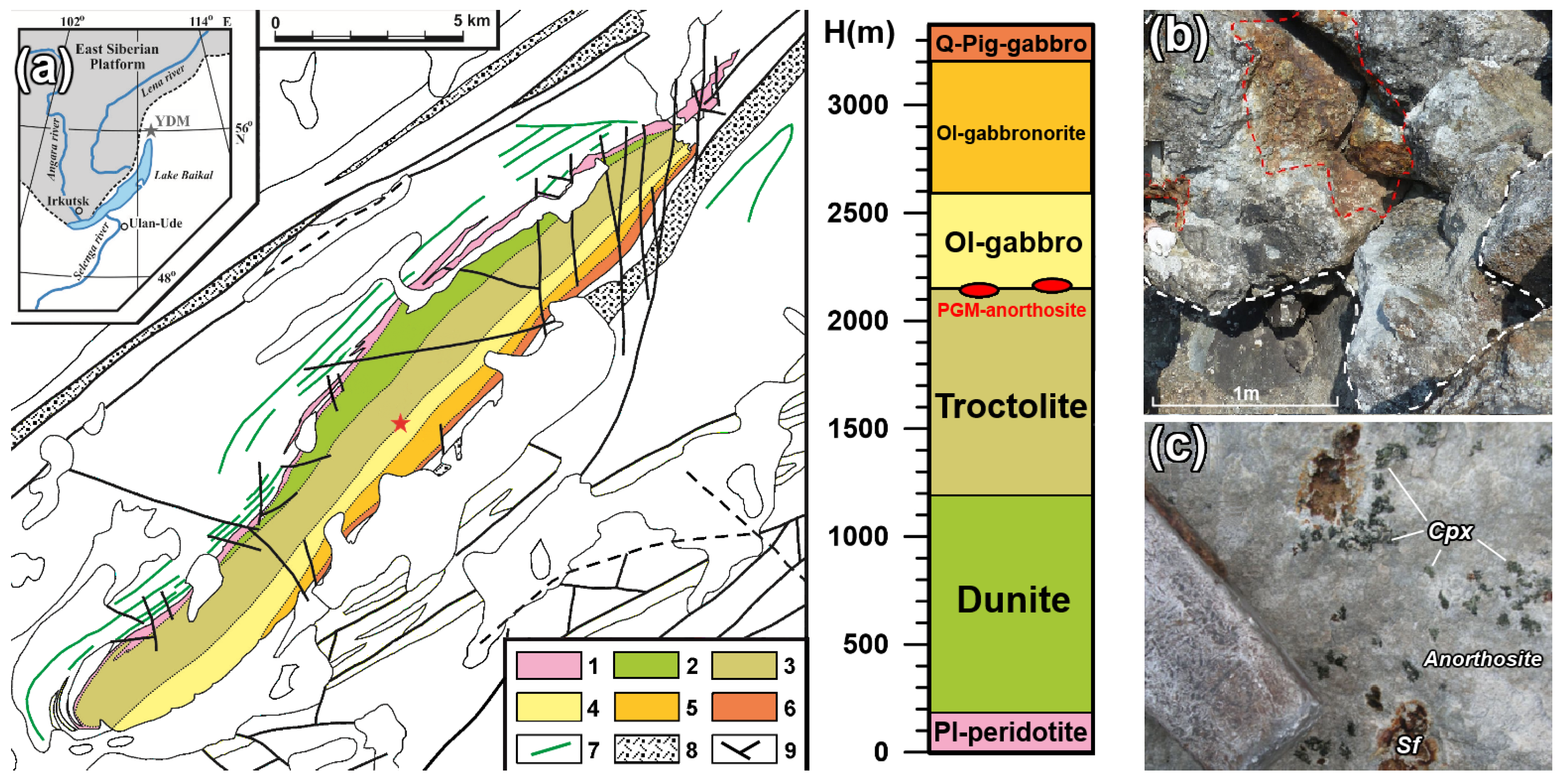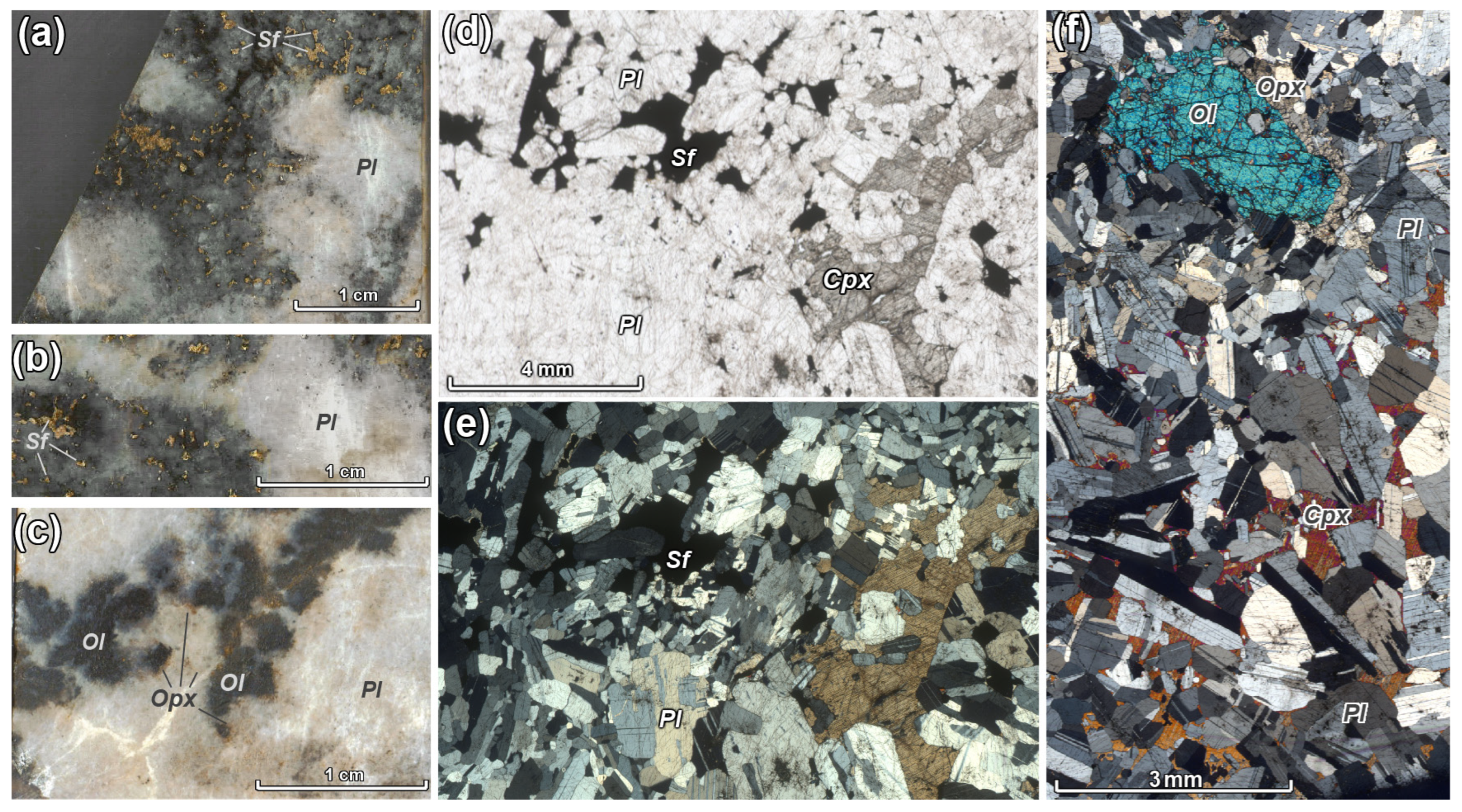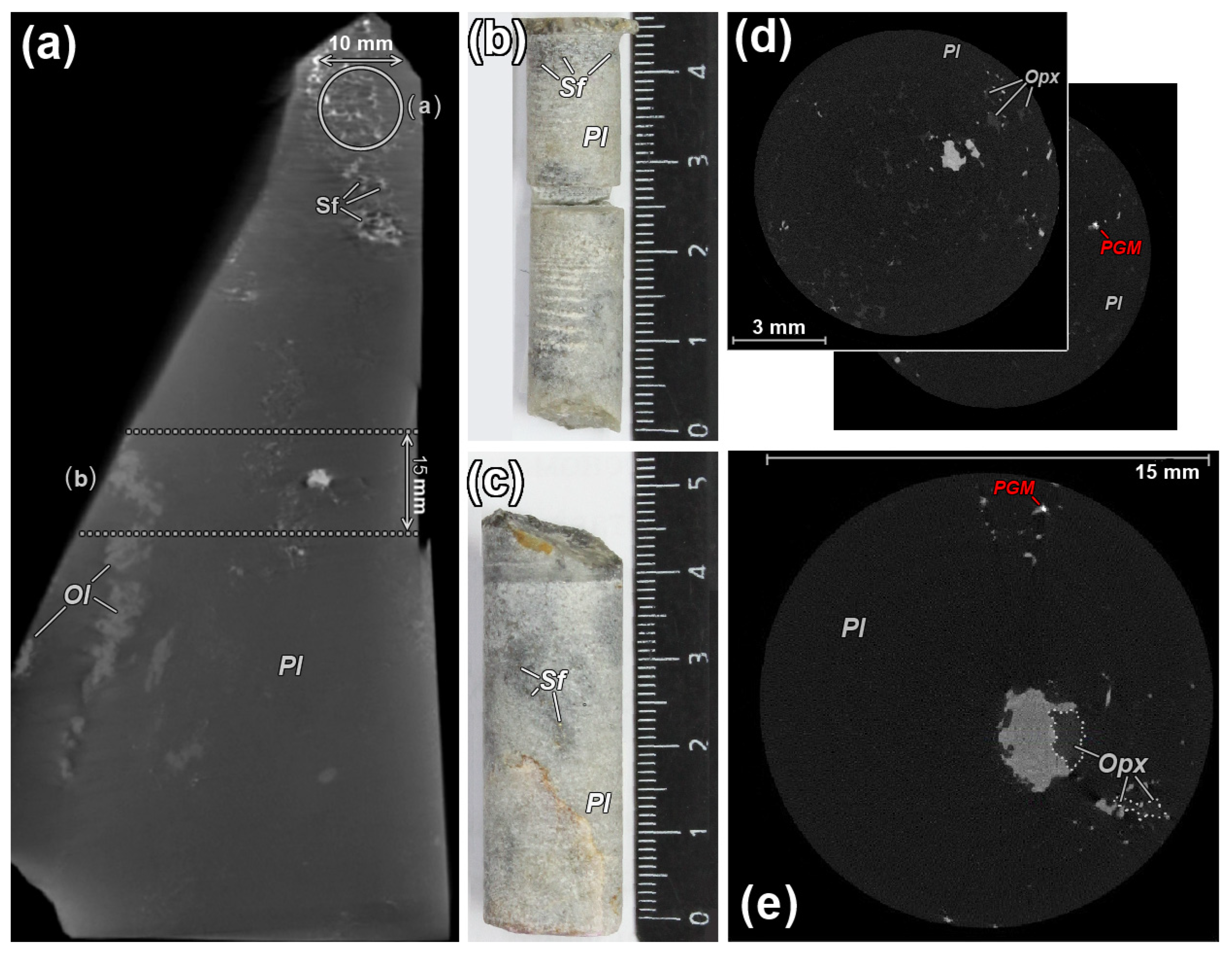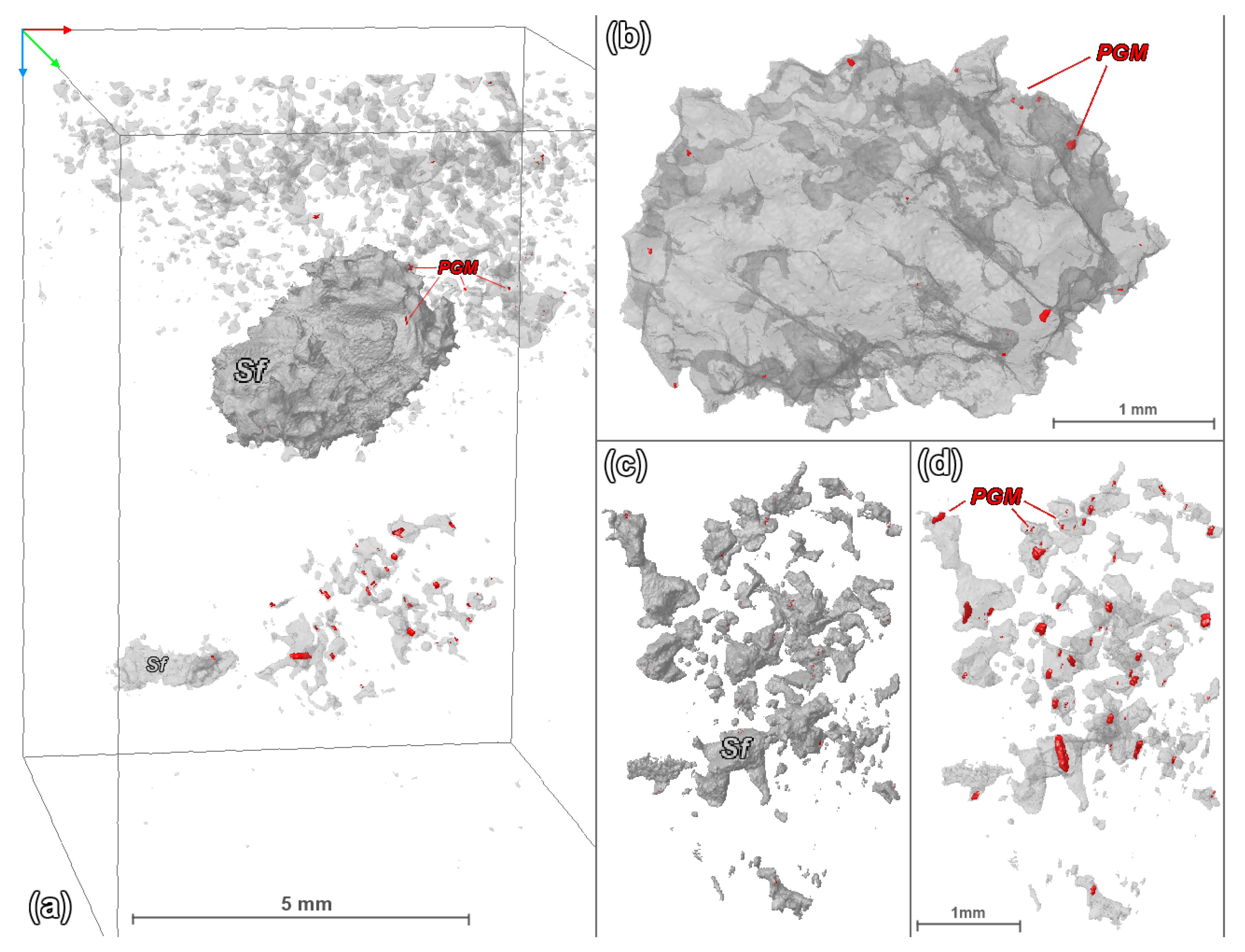Sulfide Globule and a Localized Domain Ultra-Enriched in PGMs in the Main Reef Anorthosite from the Yoko-Dovyren Massif
Abstract
1. Introduction
2. Geological Background
3. Materials and Methods
4. Results
4.1. X-Ray Computed Tomography
4.2. The Average Sulfide Compositions
4.3. SEM Studies and Mineralogy
5. Discussion
6. Conclusions
Author Contributions
Funding
Data Availability Statement
Acknowledgments
Conflicts of Interest
References
- Pshenitsyn, I.V.; Ariskin, A.A.; Korost, D.V.; Sobolev, S.N.; Yapaskurt, V.O.; Nikolaev, G.S.; Kislov, E.V. X-ray Computed Tomography of PGE-Rich Anorthosite from the Main Reef of the Yoko–Dovyren Layered Massif. Minerals 2023, 13, 1307. [Google Scholar] [CrossRef]
- Baker, D.R.; Mancini, L.; Polacci, M.; Higgins, M.D.; Gualda, G.A.R.; Hill, R.J.; Rivers, M.L. An introduction to the application of X-ray microtomography to the three-dimensional study of igneous rocks. Lithos 2012, 148, 262–276. [Google Scholar] [CrossRef]
- Barnes, S.J.; Mungall, J.E.; Le Vaillant, M.; Godel, B.; Lesher, M.C.; Holwell, D.; Peter, C.; Lightfoot, P.C.; Krivolutskaya, N.; Wei, B. Sulfide–silicate textures in magmatic Ni–Cu-PGE sulfide ore deposits: Disseminated and net-textured ores. Am. Mineral. 2017, 102, 473–506. [Google Scholar] [CrossRef]
- Barnes, S.J.; Fiorentini, M.L.; Austin, P.; Gessner, K.; Hough, R.M.; Squelch, A.P. Three dimensional morphology of magmatic sulfides sheds light on ore formation and sulfide melt migration. Geology 2008, 36, 655–658. [Google Scholar] [CrossRef]
- Godel, B.M.; Barnes, S.-J.; Maier, W.D. 3-D distribution of sulfide minerals in the Merensky Reef (Bushveld Complex, South Africa) and the J-M Reef (Stillwater Complex, USA) and their relationship to microstructures using X-ray computed tomography. J. Petrol. 2006, 47, 1853–1872. [Google Scholar] [CrossRef]
- Godel, B.M.; Barnes, S.J.; Barnes, S.-J.; Maier, D. Platinum ore in three dimensions: Insights from high-resolution X-ray computed tomography. Geology 2010, 38, 1127–1130. [Google Scholar] [CrossRef]
- Godel, B.M.; Rudashevsky, N.S.; Nielsen, T.F.D.; Barnes, S.J.; Rudashevsky, V.N. New constraints on the origin of the Skaergaard intrusion Cu–Pd–Au mineralization: Insights from high-resolution X-ray computed tomography. Lithos 2014, 190, 27–36. [Google Scholar] [CrossRef]
- Mungall, J.E.; Su, S. Interfacial tension between magmatic sulfide and silicate liquids: Constraints on kinetics of sulfide liquation and sulfide migration through silicate rocks. Earth Planet. Sci. Lett. 2005, 234, 135–149. [Google Scholar] [CrossRef]
- Pearce, M.A.; Godel, B.M.; Fisher, L.A.; Schoneveld, L.E.; Cleverley, J.S.; Oliver, N.H.S.; Nugus, M. Microscale data to macroscale processes: A review of microcharacterization applied to mineral systems. Geol. Soc. Lond. Spec. Publ. 2017, 453, 7–39. [Google Scholar] [CrossRef]
- Rose, L.A.; Brenan, J.M. Wetting properties of Fe–Ni–Co–Cu–O–S melts against olivine: Implications for sulfide melt mobility. Econ. Geol. 2001, 96, 145–157. [Google Scholar] [CrossRef]
- Holwell, D.A.; Barnes, S.J.; Le Vaillant, M.; Keays, R.R.; Fisher, L.A.; Prasser, R. 3D textural evidence for the formation of ultra-high tenor precious metal bearing sulphide microdroplets in offset reefs: An extreme example from the Platinova Reef, Skaergaard Intrusion, Greenland. Lithos 2016, 256–257, 55–74. [Google Scholar] [CrossRef]
- Robertson, J.C.; Barnes, J.S.; Le Vaillant, M.L. Dynamics of magmatic sulphide droplets during transport in silicate melts and implications for magmatic sulphide ore formation. J. Petrol. 2016, 56, 2445–2472. [Google Scholar] [CrossRef]
- Bulgatov, A.N. Teconotype of the Bakalides; Nauka: Novosibirsk, Russia, 1983. (In Russian) [Google Scholar]
- Konnikov, E.G. Differentiated Ultrabasic-Basic Complexes in the Precambrian rocks of Transbaikalia; Nauka: Novosibirsk, Russia, 1986; 127p. (In Russian) [Google Scholar]
- Gurulev, S.A. Geology and Genesis of the Yoko-Dovyren Gabbro-peridotite Massif; Nauka: Moscow, Russia, 1965. (In Russian) [Google Scholar]
- Konnikov, E.G.; Kislov, E.V.; Orsoev, D.A. The Ioko-Dovyren layered pluton and related mineralization (Northern Baikal region). Geol. Ore Depos. 1994, 36, 545–553. [Google Scholar] [CrossRef]
- Orsoev, D.A. Yoko-Dovyren dunite–troctolite–gabbro massif and its platinum potential. In Noble Metal Mineralization in the Layered Ultrabasite–Basite Massifs of the Southern Siberian Platform; Parallel: Novosibirsk, Russia, 2008; pp. 89–194. (In Russian) [Google Scholar]
- Ariskin, A.A.; Danyushevsky, L.V.; Nikolaev, G.S.; Kislov, E.V.; Fiorentini, M.L.; McNeill, A.; Kostitsyn, Y.A.; Goemann, K.; Feig, S.; Malyshev, A. The Dovyren intrusive complex (Southern Siberia, Russia): Insights into dynamics of an open magma chamber with implications for parental magma origin, composition, and Cu–Ni- PGE fertility. Lithos 2018, 302, 242–262. [Google Scholar] [CrossRef]
- Ariskin, A.A.; Danyushevsky, L.V.; Fiorentini, M.; Nikolaev, G.S.; Kislov, E.V.; Pshenitsyn, I.V.; Yapaskurt, V.O.; Sobolev, S.N. Petrology, geochemistry, and the origin of sulfide-bearing and PGE-mineralized troctolites from the Konnikov Zone in the Yoko-Dovyren Layered Intrusion. Rus. Geol. Geophys. 2020, 61, 611–633. [Google Scholar] [CrossRef]
- Konnikov, E.G.; Meurer, W.P.; Neruchev, S.S.; Prasolov, E.M.; Kislov, E.V.; Orsoev, D.A. Fluid Regime of platinum group elements (PGE) and gold-bearing reef formation in the Dovyren mafic–ultramafic layered complex, Eastern Siberia, Russia. Miner. Depos. 2000, 35, 526–532. [Google Scholar] [CrossRef]
- Orsoev, D.A. Anorthosites of the low-sulfide platiniferous horizon (Reef I) in the upper Riphean Yoko-Dovyren massif (Northern Cisbaikalia): New data on the composition, PGE–Cu–Ni mineralization, fluid regime, and formation conditions. Geol. Ore Depos. 2019, 61, 306–332. [Google Scholar] [CrossRef]
- Kislov, E.V. The Yoko-Dovyren Layered Massif; BNTs SD RAN: Ulan-Ude, Russia, 1998; 265p. (In Russian) [Google Scholar]
- Kislov, E.V.; Konnikov, E.G.; Orsoev, D.A.; Pushkarev, E.V.; Voronina, L.K. Constraints on the genesis of low-sulphide PGE mineralization at the Ioko-Dovyren layered massif, Northern Transbaikalia, Russia. In Mineral Deposits: From Their Origin to Their Environmental Impacts; Pasava, J., Kribek, B., Zak, K., Eds.; AA Balkema: Rotterdam, The Netherlands, 1995; pp. 121–124. [Google Scholar]
- Ariskin, A.A.; Tessalina, S.G.; Kostitsyn, Y.A.; Pshenitsyn, I.V.; Sobolev, S.N.; Nikolaev, G.S.; Kislov, E.V. Re-Os Systematics in the Layered Rocks and Cu-Ni-PGE Sulfide Ores from the Dovyren Intrusive Complex in Southern Siberia, Russia: Implications for the Original Mantle Source and the Effects of Two-Stage Crustal Contamination. Minerals 2023, 13, 1356. [Google Scholar] [CrossRef]
- Pshenitsyn, I.V.; Ariskin, A.A.; Nikolaev, G.S.; Kislov, E.V.; Korost, D.V.; Yapaskurt, V.O.; Sobolev, S.N. Morphology, Mineralogy, and Composition of Sulfide Droplets in Picrodolerite from a Near-Bottom Apophysis of the Yoko-Dovyren Layered Intrusion. Petrology 2020, 28, 246–262. [Google Scholar] [CrossRef]
- Ramdohr, P. The Ore Minerals and Their Intergrowths; Pergamon Press Ltd.: Oxford, UK, 1969; 1178p. [Google Scholar]
- Laskar, C.; Bazarkina, E.F.; Kokh, M.A.; Hazemann, J.-L.; Vuilleumier, R.; Desmaele, E.; Pokrovski, G.S. Stability and structure of platinum sulfide complexes in hydrothermal fluids. Geochim. Cosmochim. Acta 2022, 336, 407–422. [Google Scholar] [CrossRef]
- Tagirov, B.R.; Baranova, N.N.; Zotov, A.V.; Akinfiev, N.N.; Polotnyanko, N.A.; Shikina, N.D.; Koroleva, L.A.; Shvarov, Y.V.; Bastrakov, E.N. The speciation and transport of palladium in hydrothermal fluids: Experimental modeling and thermodynamic constraints. Geochim. Cosmochim. Acta 2013, 117, 348–373. [Google Scholar] [CrossRef]
- Filimonova, O.N.; Tagirov, B.R.; Zotov, A.V.; Baranova, N.N.; Bychkova, Y.V.; Tyurin, D.A.; Chareev, D.A.; Nickolsky, M.S. The solubility of cooperite PtS(cr) at 25–450 °C, Psat–1000 bar and hydrosulfide complexing of platinum in hydrothermal fluids. Chem. Geol. 2021, 559, 119968. [Google Scholar] [CrossRef]







| Sample | Silicates | Sulfides | p.PGMs | p.PGM | |
|---|---|---|---|---|---|
| Content, vol.% | Content, vol.% | Connectivity, % | Numbers (vol, %) | Maximum Linear Diameter (μm) | |
| DV653-5 | |||||
| 653-5—10 mm | 97.56 | 2.44 | 25 | 65 (0.001) | 60 |
| 653-5—15 mm | 98.86 | 1.14 | 70 | 71 (0.001) | 450 |
| 15 mm (A) | 95.79 | 4.21 | 100 | 18 (0.0001) | 35 |
| 15 mm (B) | 99.32 | 0.68 | 19 | 45 (0.01) | 450 |
| Mineral | S (wt.%) | Fe | Co | Ni | Cu | Pt | Pd | Total | Formulae |
|---|---|---|---|---|---|---|---|---|---|
| Po (Tr) | 36.22 | 62.98 | 0.21 | bdl 1 | bdl | bdl | bdl | 99.41 | Fe1.00Co0.01S |
| Po (Tr) | 36.23 | 63.55 | 0.33 | bdl | bdl | bdl | bdl | 100.11 | Fe1.01Co0.01S |
| Cub | 35.15 | 40.95 | 0.14 | bdl | 22.75 | bdl | bdl | 98.99 | Cu0.98Fe2.01Co0.01S3 |
| Cub | 35.39 | 41.22 | 0.24 | bdl | 23.19 | bdl | bdl | 100.04 | Cu0.99Fe2.01Co0.01S3 |
| Ccp | 34.66 | 30.97 | 0.12 | bdl | 34.36 | bdl | bdl | 100.11 | Cu1.00Fe1.03Co0.01S2 |
| Ccp | 34.38 | 30.73 | 0.15 | bdl | 33.61 | bdl | bdl | 98.87 | Cu0.99Fe1.03Co0.01S2 |
| Pn (glob) | 32.99 | 35.3 | 0.79 | 29.87 | bdl | 0.18 | bdl | 99.13 | (Ni3.96Fe4.92Co0.10)S8 |
| Pn (glob) | 32.92 | 35.56 | 1.09 | 29.81 | bdl | 0.23 | bdl | 99.61 | (Ni3.96Fe4.96Co0.14)S8 |
| Pn (nest) | 32.8 | 35.15 | 0.87 | 30.13 | bdl | bdl | 1.23 | 100.18 | (Ni4.00Fe4.95Co0.12)S8 |
| Pn (nest) | 33.02 | 35.12 | 0.94 | 30.23 | bdl | bdl | 0.89 | 100.2 | (Ni4.00Fe4.89Co0.12)S8 |
| Mineral | Pd (wt.%) | Sn | Te | Pt | Bi | Hg | Fe | Ni | Cu | Pb | Total |
|---|---|---|---|---|---|---|---|---|---|---|---|
| Moncheite | bdl 1 | bdl | 49.91 | 41.56 | 7.74 | bdl | bdl | bdl | bdl | bdl | 99.21 |
| Moncheite | bdl | bdl | 51.21 | 40.98 | 6.33 | bdl | bdl | bdl | bdl | bdl | 98.52 |
| Moncheite | bdl | bdl | 50.91 | 41.76 | 5.91 | bdl | bdl | bdl | bdl | bdl | 98.58 |
| Unnamed Pt2Pd2Sn | 28.43 | 21.8 | bdl | 48.93 | bdl | bdl | bdl | bdl | bdl | bdl | 99.16 |
| Unnamed Pt2Pd2Sn | 25.69 | 21.56 | bdl | 51.58 | bdl | bdl | bdl | bdl | bdl | bdl | 98.83 |
| Tetraferroplatinum | 4.05 | bdl | bdl | 82.65 | bdl | bdl | 11.59 | 0.48 | 1.27 | bdl | 100.04 |
| Tetraferroplatinum | 1.57 | bdl | bdl | 83.85 | bdl | bdl | 11.79 | 0.66 | 2.02 | bdl | 99.89 |
| Tetraferroplatinum | 1.31 | bdl | bdl | 74.66 | bdl | bdl | 14.58 | 0.94 | 7.5 | bdl | 98.99 |
| Potarite | 35.47 | bdl | bdl | bdl | bdl | 61.3 | 1.56 | bdl | bdl | bdl | 98.33 |
| Potarite | 33.42 | bdl | bdl | bdl | bdl | 62.56 | 0.51 | bdl | 0.67 | bdl | 97.16 |
| Zvyagintsevite | 57.08 | bdl | bdl | 1.18 | bdl | 1.55 | 0.49 | bdl | 0.54 | 35.66 | 96.5 |
| Zvyagintsevite | 58.04 | bdl | bdl | 1.04 | bdl | 2.64 | 0.24 | bdl | bdl | 35.44 | 97.4 |
Disclaimer/Publisher’s Note: The statements, opinions and data contained in all publications are solely those of the individual author(s) and contributor(s) and not of MDPI and/or the editor(s). MDPI and/or the editor(s) disclaim responsibility for any injury to people or property resulting from any ideas, methods, instructions or products referred to in the content. |
© 2025 by the authors. Licensee MDPI, Basel, Switzerland. This article is an open access article distributed under the terms and conditions of the Creative Commons Attribution (CC BY) license (https://creativecommons.org/licenses/by/4.0/).
Share and Cite
Pshenitsyn, I.V.; Ariskin, A.A.; Korost, D.V.; Sobolev, S.N.; Yapaskurt, V.O.; Nikolaev, G.S. Sulfide Globule and a Localized Domain Ultra-Enriched in PGMs in the Main Reef Anorthosite from the Yoko-Dovyren Massif. Minerals 2025, 15, 160. https://doi.org/10.3390/min15020160
Pshenitsyn IV, Ariskin AA, Korost DV, Sobolev SN, Yapaskurt VO, Nikolaev GS. Sulfide Globule and a Localized Domain Ultra-Enriched in PGMs in the Main Reef Anorthosite from the Yoko-Dovyren Massif. Minerals. 2025; 15(2):160. https://doi.org/10.3390/min15020160
Chicago/Turabian StylePshenitsyn, Ivan V., Alexey A. Ariskin, Dmitry V. Korost, Sergei N. Sobolev, Vasily O. Yapaskurt, and Georgy S. Nikolaev. 2025. "Sulfide Globule and a Localized Domain Ultra-Enriched in PGMs in the Main Reef Anorthosite from the Yoko-Dovyren Massif" Minerals 15, no. 2: 160. https://doi.org/10.3390/min15020160
APA StylePshenitsyn, I. V., Ariskin, A. A., Korost, D. V., Sobolev, S. N., Yapaskurt, V. O., & Nikolaev, G. S. (2025). Sulfide Globule and a Localized Domain Ultra-Enriched in PGMs in the Main Reef Anorthosite from the Yoko-Dovyren Massif. Minerals, 15(2), 160. https://doi.org/10.3390/min15020160






